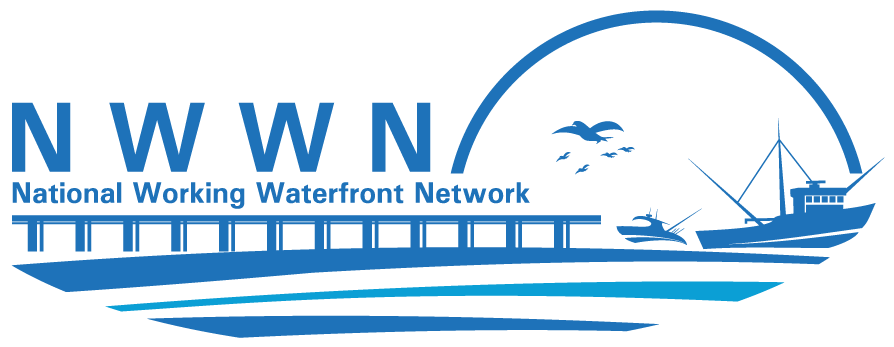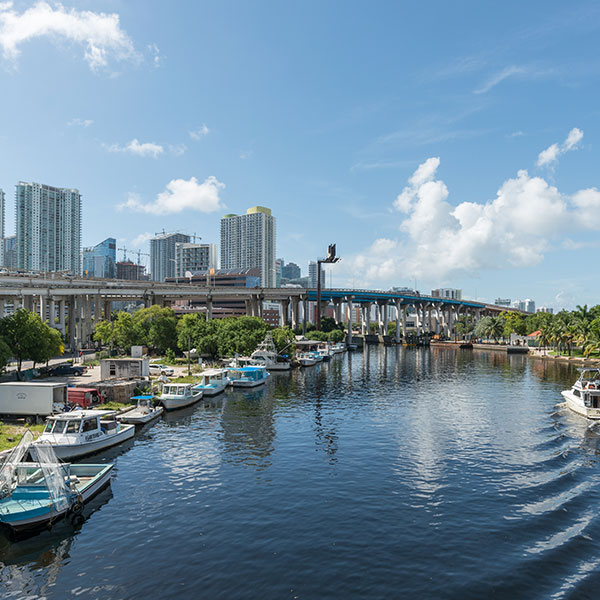Case Study
Port of the Miami River Water Dependent Land Use Litigation Case Study
Location
Miami, Florida
Timeframe
2004 – 2006; 2010 & 2011
Summary
The Port of Miami River is located along the banks of the Miami River, Florida and its tributaries and canals. It is a shallow draft, riverine port consisting of independent, privately-owned small shipping companies, fisheries, vessel repair facilities, marinas and other recreational and commercial working waterfront uses. The Port extends from the salinity dam in unincorporated Miami-Dade County to Biscayne Bay in the City of Miami.
In 2004 and 2006, the Miami City Commission approved three controversial, multifamily mixed-use developments on the Miami River. To legitimize the developments’ rezoning and special use permits, the City amended its Future Land Use Map (FLUM) from “marine industrial” to “high density residential.” The property in question lies within an historically important cluster of maritime uses that had been given special overlay protection in the City’s comprehensive plan and zoning regulation.
In response to potential loss of water-dependent marine and industrial commerce, the Miami River Marine Group, a trade association representing marine and industrial businesses along the Miami River, along with other appellants, challenged the FLUM amendments. In 2010, the Third District Court of Appeals found that the amendments violated state statutory limitations and prohibitions on comprehensive plan amendments; the city zoning code’s designation of the area as a protected maritime district designed to prevent residential development; the Miami River Master Plan; and the Port of Miami River comprehensive plan sub-element.
Transferability
The land use law process for comprehensive planning is somewhat unique to Florida. What is transferable is the ability of a small group of like-minded maritime interests, who compete commercially, to come together in the face of a common threat and use litigation to challenge a political decision to convert traditional water-dependent uses.
Best Practices
- Creation of an informal port – Port of Miami River
- Creation of trade association – Miami River Marine Group
- Retention of an experienced Land Use lawyer
Full Case Study Description
Background
Unlike its sister port, The Port of Miami, The Port of Miami River does not enjoy statutory port status. Instead, it depends on local land use law to protect its historic water dependent maritime uses. The recent real estate bubble caused the City of Miami to prefer high value residential development along the riverfront over traditional industrial and commercial waterfront uses. In the face of economic development pressure, The City of Miami moved to change the land use categories to allow the conversion of the waterfront to non-water dependent uses. Faced with the loss of industrial waterfront, litigation under Florida’s unique system of land use law became the only avenue to maintain the integrity of the Port.
Actions and Approaches
Proactive efforts of the Miami River Marine Group, Inc., trade association demonstrate the effectiveness of the partnership among the commercial and industrial interests along the Miami River. In addition to the Miami River Marine Group, Inc., appellants challenging the FLUM amendments included a tugboat company owner and operator, a local resident, and a non-profit neighborhood association composed of approximately 90 homeowners and businesses in the area. Together, these appellants petitioned the Department of Administrative Hearings (DOAH) to challenge the local ordinance that approved the FLUM amendment. The appellants sought review in the Third District Court of Appeal of the Florida Department of Community Affairs’ final order adopting the DOAH administrative law judge’s recommended order, which upheld the City’s FLUM amendments.
Policy Framework
Pursuant to Florida’s Growth Management Act, Chapter 163, Part II, The City held a transmittal public hearing for the FLUM amendments. The Florida Department of Community Affairs reviewed the amendments and found them in compliance with the Act as well as state, regional, and local plans; the amendments were enacted at an adoption public hearing by the City Commission. The appellants expressed their opposition to the amendments during the entire process and filed their DOAH petition challenging the amendments within 30 days after the adoption hearing. After more than six years of litigations, the City, State and appellants – but not the developers – agreed to adopt pro-working waterfront goals, objectives and policies into the City’s comprehensive plan.
[Noteworthy: A year after the 2011 agreement, the Florida Growth Management Act was amended to the “Community Planning Act,” which dramatically reduced state oversight of local comprehensive planning. In hindsight, the outcomes of the Port of Miami River litigation and the agreement may have been different, had they occurred under the current act.]
Key Partners
Florida Marine Industries Association
Miami River Marine Group
Contacts
Andrew Dickman
Attorney for Miami River Marine Group
andrewdickman@comcast.net
John Sprague
Florida Marine Industries Association
miafoperations@boatflorida.org
References
Payne v. City of Miami, 913 So. 2d 1260 (Florida, 2005)
Payne v. City of Miami, 927 So. 2d 904 (Florida App., 2005)
Payne v. City of Miami, 52 So. 3d 707 (Florida 3d DCA 2010)
Payne v. City of Miami, 53 So. 3d 258 (Florida App., 2010)
The Durham Park Neighborhood Association Inc., v. City of Miami, 53 So. 3d 245 (Florida App., 2010)
Balbino Investments & Riverside Investments v. Payne et al., SC11-75 (Aug. 4, 2011)
Last updated 25-Mar-13


